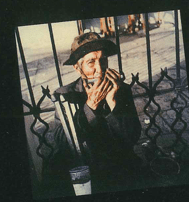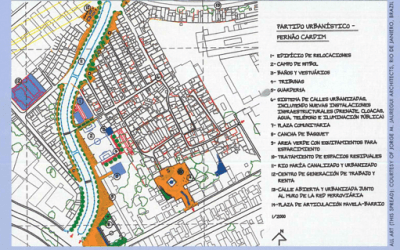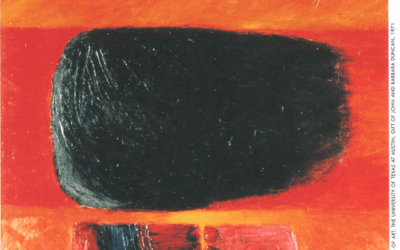Exploring Things Mayan and Modern
A History of Latin American Arts at Harvard
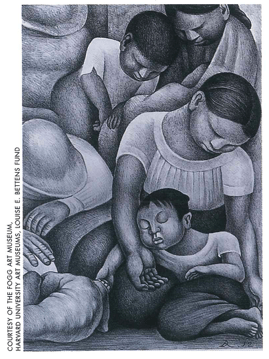
Diego Rivera, Sleep, 1932.
The Agnes Mongan Center for the Study of Prints, Drawings, and Photographs at Harvard’s Fogg art museum houses most of the university’s Latin American art collection. I am here from the David Rockefeller Center for Latin American Studies (DRCLAS) to find pieces that graduate student Mercedes Trelles reported on for DRLCAS in 1998 as the Center sought to identify the scope of Latin American art at Harvard. I anticipated strolling past artwork hung from the walls, noting the title, the caption, and what type of process the artist used. Instead, I have specified the prints I want to look at — from a card catalog — and am waiting for the clerk to bring them out. Several people are sitting at the long tables studying their selections on handy tabletop easels.
My prints arrive. The clerk takes the top piece and tells me not to touch the bevelled edge of the paper matte frame. She lifts the frame and shows me how to remove the protective tissue paper — you lift it up, she says, don’t drag it across the piece. Underneath are women, black plaited hair reaching down their backs, and men with sombreros. Their heads are bowed as they sleep with their children. This is unmistakable Diego Rivera — broad foreheads and arms, sturdy, larger-than-life hands folded over loved ones.
“Sleep,” dated 1932, was acquired by the Fogg’s assistant director at the time, Paul Sachs. According to the current curator of the Mongan Center, Marjorie Cohn, in the 1930s and 1940s, Sachs collected works of other Mexican muralists and artists as well, including prints by Rufino Tamayo, José Clemente Orozco, and Leopoldo Mendez. Agnes Mongan continued this trend by acquiring more Mexican works through the early 1970s by artists such as Jean Charlot, Francisco Dosamontes, Raul Anguiano, Davíd Alfaro Siquieros, Rafael Coronel, José Luis Cuevas, Carlos Merida, and Alfredo Zalce. Most of these pieces are lithographs, some in color.
Drawings by Chilean artist Robert Matta Echaurren and a sculpture and drawing by Francisco Zuí±iga were purchased by the museum in the 1970s and 1990s. Recently the Fogg has added works by Enrique Chagoya and Luis Jiménez, both printmakers of Latin American background. Soon the museum will acquire 85 woodcuts by Cuban artist Antonio Canet, originally a gift to DRCLAS. Most recent acquisitions in the Mongan Center are the work of curator Marjorie Cohn.
The Department of Photographs at the Fogg has also collected Latin American works. Many of these are gelatin silver prints, black and white photos. Artists in this collection include Manuel Alverez Bravo and Lola Alverez Bravo, both Mexican; Antonio Mendoza, Cuban-born; Luis Gonzales Palma, Guatemalan; Anna Bella Geiger, Brazilian; Rogerio Reis, Brazilian; Abelardo Morell, Cuban-born; and Oscar Palacio, Colombian. These photographs range from the pop art, political statements of Anna Bella Geiger to the ‘camera-obscura’ technique employed by Abelardo Morell, where he turns an entire room into a camera and imposes the picture it takes onto the wall of the room. Many of these were gifts to the museum, collected between the 1940s and 1990s.
Harvard University began its exploration of Latin American art in the late 1800s when Harvard faculty brought back Mayan objects from Copan, Honduras, and Chichen Itza. These objects became part of the collection at the Peabody, the Harvard’s ethnography museum, and were first on view at the Fogg, which earned credit in the 1930s for being the only museum in America at the time to exhibit these artifacts as art. Now they are on display on the third floor of the Peabody, the Latin American floor.
For many years afterwards, Harvard’s commitment to Latin American arts remained fixed in its museum collections. Recently, however, many on campus have explored new definitions of Latin American art, which include modern works in many genres, and have boldly advanced the space where Latin American art is now displayed and studied.
When DRCLAS moved into its present building at 61 Kirkland St., Cambridge, in 1997, Harvard graduate student Chris Tirres noted the ample bare walls and conceived the idea of a juried art competition. Since then, DRCLAS has established more than a dozen exhibitions as part of its Latin American and Latino Art Forum.
In the fall of 1999, Winifred Godfrey’s “Mayan Procession” was on display; her life-size oil paintings spanned entire walls. “They were stunning,” said then-Acting Director Otto Solbrig. “They were not abstract, yet quite symbolic.” He said he enjoyed her work because she captured the stoicism of Guatemalan women even while displaying the vivid colors of the textiles they wear daily.
A large black and white photograph remains at the Center from Jack Lueders-Booth’s photoessay of people who live on or near the dumps in Tijuana, Mexico. In this photo a young woman leans against a truck filled with garbage, which rises past the edge of the picture. DRCLAS supported both his work and that of Laura Blacklow, a lecturer in Harvard’s Department of Visual and Environmental Studies who recently traveled to Guatemala to teach photography.
Contributing to the mix at Harvard is Latino Cultures, an interdisclipinary course on the Latin American diaspora taught by Doris Sommer from the Department of Romance Languages and Literatures (RLL) and Marcelo Suárez-Orozco from the Harvard Graduate School of Education, with DRCLAS funding. In 1998 and 1999, guest speaker Tomas Ybarra Frausto, an art scholar and Rockefeller Foundation program officer, spoke to the class about Latin American art trends.
Professor José Mazzotti is one of several RLL professors who regularly incorporates Latin American art themes in their courses. “I use a great deal of material such as slides of paintings by Cuban Wilfredo Lam, Mexican Tamayo, Peruvian Carlos Runcie Tanaka and Tilsa Tsuchya and other artists to illustrate the periods and cultural trends of which literary texts also talk.” He also brings in film, “to explain historical processes like the Cuban revolution,” and music, “from Mexican corridos to Afro-Caribbean and Afro-Peruvian songs.”
Over the years the Harvard Film Archive (HFA) has made Latin films accessible to US audiences, broadening the definition of Latin American art further. In addition to the films by celebrated Spanish filmmaker Luis Bunuel, the HFA has sponsored several series dedicated to Latin American cinema, including the Glauber Rocha films comprising his “Trilogy of the Earth.” These are political, often exposing the raw face of conflict between landowners and the poor in Brazil. Most recently the HFA hosted an experimental series, 20 films from Mexico’s government film industry, Cinematic D.F. Both fiction and non-fiction, some offered a humorous look at politics, including one that parodied ex-President Salinas’ flight out of the country. Steffen Pierce, Assistant Curator at the Archive, said that it’s “very hard to get films out of Central and South America. They have been swamped with American product, which has made such inroads into those markets that it’s very hard to keep a vital film industry going.” Pierce added that while the Archive does have some Mexican, Brazilian, and Chilean films, and the Bunuel films, in their permanent collection, most of the Latin American films they show are on campus only temporarily. He said they would definitely like to expand their Latin American holdings.
Some Harvard departments have collaborated with off campus sites to promote Latin American art. Jessica Morgan, curator at the Institute of Contemporary Art (ICA) in Boston, recounts a 1997 installation art exhibit they put together with Harvard’s Visual and Environmental Studies department. The exhibit featured the work of Brazilian conceptual artist Cildo Meireles, “a sculptor who constructs a piece, or many pieces, and the space in which it will be displayed,” Morgan explained. Meireles works in 3-D, sometimes incorporating found objects.
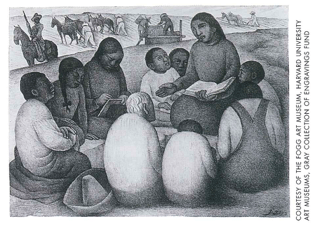
Diego Rivera, Open Air School, 1930.
Ellen Phelan of the Carpenter Center at Harvard described one of Meireles’ pieces that was displayed there during the joint show with the ICA. Entitled ‘How to Build a Cathedral,’ it consisted of a square of cinder blocks measuring 20′ X 20′, filled with pennies. Thousands of cow bones hung above; the perimeter was swathed in black. “One of the things that interests me about Latin American artwork at this time,” Phelan commented, is the artists’ “appropriation of minimalist forms from the 1960s and 1970s, which they load with political content. You don’t often see that in the US.” It may seem like a contradiction, she said, to load a minimalist piece. But she thinks Meireles’ work “is extremely graceful.”
Mercedes Trelles’ report, which prompted this pilgrimage across campus, finally takes me to the third floor of the Peabody museum. I walk across the uneven hardwood floor, itself a hundred years old, and note the Mayan cookware. Large, heavy, ceramic dishes were made ornate by effigies of animals atop lids — I see a jaguar and a parrot. Another glass case displays ornaments, earrings, pendants, headbands, belts, and something called lip plugs made out of greenstone, shell, and ceramic. Sharp edged stone daggers remind me that this society believed in the ritual of blood sacrifice. And there are stone likenesses of the gear — mostly heavy belts — that men wore while playing ball.
Next I walk among the imposing stelae, towering stone columns, dating back to AD 600. Many of these are casts of the originals, all from the Mayan court at Yaxchilan. They tell stories of the Mayans, a class bound and ritualistic society, through pictograms carved onto the giant columns. The exhibit instructs visitors on how to decipher the drawings: read double columns of glyphs from top to bottom; the glyphs trace the cycles of life, work, and death.
The stories of these early artists are still being told, and many more are to come, with the expansive, campus-wide outreach at Harvard today, which is exploring Latin American art in its many forms and its many creators.
Winter/Spring 2001
Susie Seefelt Lesieutre was a publications intern at DRCLAS for the fall semester and is currently working with the center’s publications director. she is enrolled in the certificate for publishing and communications program at Harvard Extension. In 1990 she received a master’s degree in TESL; she has taught ESL in the US and abroad. This article draws on a 1998 report on Latin American Arts at Harvard by Mercedes Trelles.
Related Articles
Guatemala Diary
In a deeply personal way, I feel like I am home again. Of all the places I have visited, Guatemala is the country I love and feel closest to. Certainly the most impressive aspect is the persevering Mayan people, who endured a 30-year civil war…
From Favela to Bairro
The Brazilian firm of Jorge Mario J¡uregui Architects is the first Latin American recipient of the Harvard Graduate School of Design’s Veronica Rudge Green Award in Urban Design. The award…
Exploring New Horizons in Latin American Contemporary Art
When I first traveled to Peru by boat with my family fifty years ago, the country seemed as far away from Argentina as Boston from Buenos Aires. My husband had been sent there by W.R…

